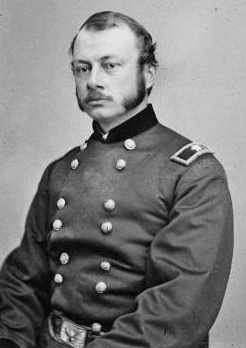Robert Brown Potter facts for kids
Quick facts for kids
Robert Brown Potter
|
|
|---|---|

Robert Brown Potter
|
|
| Born | July 16, 1829 Schenectady, New York, U.S. |
| Died | February 19, 1887 (aged 57) Newport, Rhode Island, U.S. |
| Place of burial |
Woodlawn Cemetery, The Bronx, New York, U.S.
|
| Allegiance | United States of America Union |
| Service/ |
United States Army Union Army |
| Years of service | 1861-1866 |
| Rank | |
| Commands held | 51st New York Volunteer Infantry |
| Battles/wars | American Civil War: • Battle of New Bern • Second Bull Run • Battle of Antietam • Siege of Vicksburg • Knoxville Campaign • Overland Campaign • Siege of Petersburg • Battle of Fort Stedman |
Robert Brown Potter (born July 16, 1829 – died February 19, 1887) was an American lawyer who became an important general in the Union Army during the American Civil War. He fought in many major battles and played a key role in several campaigns.
Contents
Early Life and Family
Robert Brown Potter was born in Schenectady, New York, on July 16, 1829. His father was Alonzo Potter, who was a bishop in the Episcopal Church. His mother, Sarah Maria, was the daughter of Eliphalet Nott, who was the president of Union College.
Robert had eight brothers and one sister. His family was well-known, and many of his siblings also became successful. For example, his brother Clarkson Nott Potter became a member of the U.S. House of Representatives. Another brother, Henry Codman Potter, also became a bishop.
Before the Civil War began, Robert Potter worked as a lawyer in New York City.
Military Career in the Civil War
When the Civil War started, Robert Potter joined the New York militia as a private soldier. He quickly showed his skills and was promoted several times.
Joining the Fight
- On October 14, 1861, he became a major.
- On November 1, 1861, he was promoted to lieutenant colonel.
He was part of the 51st New York Volunteer Infantry regiment.
Key Battles and Promotions
Potter was wounded in his first major battle, the Battle of New Bern, on March 14, 1862. He was serving under Brigadier General Ambrose E. Burnside at the time.
Later, he commanded his regiment at the Second Battle of Bull Run. On September 10, he was promoted to colonel. He then led his regiment at the Battle of Antietam, where he was wounded again during Burnside's attack.
Leading Divisions and Corps
On March 13, 1863, Potter was promoted to brigadier general. He led the 2nd Division of the IX Corps during the important Siege of Vicksburg. After that, he commanded the entire IX Corps during the Knoxville Campaign.
In 1864, he returned to lead the 2nd Division of IX Corps under General Burnside. He led his division through the tough Overland Campaign and during the long Siege of Petersburg. He was wounded one last time after the Battle of Fort Stedman, which meant he missed the final battles of the war.
End of Service
After he recovered, Robert Potter was given command of the military district that included Rhode Island and Connecticut. On his wedding day, he received his commission as a full major general of volunteers. He officially left the volunteer service on January 15, 1866.
Life After the War
After leaving the military, Robert Potter worked for three years as a receiver for the Atlantic and Great Western Railroad. In 1869, he moved to England. However, he returned to Rhode Island in 1873.
Personal Life
On September 20, 1865, General Potter married Abigail Austin "Abby" Stevens. Abby was the daughter of a well-known banker named John Austin Stevens.
Robert Brown Potter passed away in Newport, Rhode Island, on February 19, 1887. He was buried at Woodlawn Cemetery in the Bronx, New York City.

